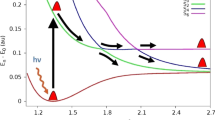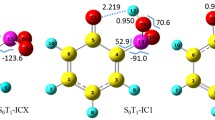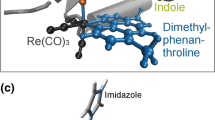Abstract
The photodissociation dynamics of hydrazoic acid (HN3) at 248 nm has been studied using a quasi-classical variant of the trajectory surface-hopping (TSH) method in conjunction with Tully’s fewest switches algorithm. Trajectories were integrated on-the-fly at the MRCIS(8,9)/6-31++G(d,p) level of theory. Analysis of our trajectory simulation reveals that N2 (\(\widetilde{\mathrm{X}}\) 1Σg+) + NH (a 1Δ) as the primary major products contributing ~95% of the overall product formation with N3 \(\left(\widetilde{X }{ }^{2}{\Pi }_{\mathrm{g}}\right)\) + H(2S) as the minor products contributing the rest ~5%. No internal conversion (IC) from the first excited state S1 to the ground state S0 was observed in the photodissociation of HN3 from its first excited singlet state (S1). Intersystem crossing (ISC) from the first excited singlet state S1 to the lowest triplet state T1 was predicted to be inefficient based on the calculated weak spin-orbit interactions between the states.
Graphical abstract
Synopsis We have studied the photodissociation dynamics of hydrazoic acid (HN3) using the trajectory surface-hopping (TSH) method. Our trajectory simulation reveals that N2 (\(\widetilde{\mathrm{X}}\) 1Σg+) + NH (a 1Δ) as the primary major products contributing ~95% of the overall product formation with N3 \(\left(\widetilde{X }{ }^{2}{\Pi }_{\mathrm{g}}\right)\) + H(2S) as the minor products contributing the rest ~5%. No internal conversion (IC) was observed, and intersystem crossing (ISC) was predicted to be inefficient.





Similar content being viewed by others
References
Yuan K, Cheng Y, Wang F and Yang X 2008 Photodissociation Dynamics of HN3 and DN3 at 157 nm J. Phys. Chem. A 112 5332
Friedmann A, Soliva A M, Nizkorodov S A, Bieske E J and Maier J P 1994 A 3∏u<-- X 3∑g- Electronic Spectrum of N3+ J. Phys. Chem. 98 8896
Orlando J J, Tyndall G S, Betterton E A, Lowry J and Stegall S T 2005 Atmospheric Chemistry of Hydrazoic Acid (HN3): UV Absorption Spectrum, HO. Reaction Rate, and Reactions of the .N3 Radical Environ. Sci. Technol. 39 1632
Foy B R, Casassa M P, Stephenson J C and King D S 1988 Unimolecular Dynamics Following Vibrational Overtone Excitation of HN3 v1 = 5 and v1 = 6: HN3(X;v, J, K)→HN(X 3Σ−;v, J, Ω)+N2(X 1Σg+) J. Chem. Phys. 89 608
Foy B R, Casassa M P, Stephenson J C and King D S 1989 Dissociation Lifetimes and Level Mixing in Overtone-Excited HN3(X1A′) J. Chem. Phys. 90 7037
Foy B R, Casassa M P, Stephenson J C and King D S 1990 Overtone-Excited HN3(X1A′): Anharmonic Resonance, Homogeneous Linewidths, and Dissociation Rates J. Chem. Phys. 92 2782
Rohrer F and Stuhl F 1988 The 193 (and 248) nm photolysis of HN3: Formation and internal energy distributions of the NH (a 1Δ, b 1∑+, A 3Π, and c 1Π) states J. Chem. Phys. 88 4788
Gericke K-H, Theinl R and Comes F 1990 Vector correlations in the photofragmentation of HN3 J. Chem. Phys. 92 6548
Baronavski A P, Miller R G and McDonald J R 1978 Laser induced photodissociation of HN3 at 266 nm. I. Primary products, photofragment energy distributions and reactions of intermediates Chem. Phys. 30 119
Gericke K-H, Theinl R and Comes F J 1990 Photofragment energy distribution and rotational anisotropy from excitation of HN3 at 266 nm Chem. Phys. Lett. 164 605
Gericke K-H, Theinl R and Comes F 1989 Photofragment energy distribution and rotational anisotropy from excitation of HN3 at 266 nm J. Chem. Phys. Lett. 164 605
Chu J J, Marcus P and Dagdigian P J 1990 One-color photolysis–ionization study of HN3: The N2 fragment internal energy distribution and μ-v-J correlations J. Chem. Phys. 93 257
Gericke K-H, Haas T, Lock M, Theinl R and Comes F J 1991 Hydrazoic acid (Ã 1A'') hypersurface at excitation energies of 4.0-5.0 eV J. Phys. Chem. 95 6104
Lock M, Gericke K-H and Comes F 1996 Photodissociation dynamics of HN3(DN3) + hv → H(D)+ N3 J. Chem. Phys. 213 385
Cook P A, Langford S R and Ashfold M N R 1999 The Ultraviolet Photodissociation of HN3: The H + N3 Product Channel Phys. Chem. Chem. Phys. 1 45
Haas T, Gericke K-H, Maul C and Comes F J 1993 Photodissociation Dynamics of HN3. The N3 Fragment Internal Energy Distribution Chem. Phys. Lett. 202 108
Hawley M, Baronavski F and Nelson H H 1993 Vibrational distributions of NH (a 1Δ) from the photolysis of HN3 from 220–290 nm J. Chem. Phys. 99 2638
Gericke K-H, Lock M and Comes F J 1991 Photodissociation of HN3: Direct Formation of Hydrogen Atoms Chem. Phys. Lett. 186 427
Schoennenbeck G, Biehl H, Stuhl F, Meier U and Staemmler V 1998 Vuv photolysis of hydrazoic acid: Absorption and fluorescence excitation spectra J. Chem. Phys. 109 2210
Zhang J S, Xu K S and Amaral G 1999 Ultraviolet photodissociation dynamics of HN3: the H+N3 channel Chem. Phys. Lett. 299 285
Cook P A, Jimeno P, Ashfold M N R, Balint-Kurti G G and Dixon R N 2002 An ab initio study of the photodissociation of HN3 molecules following excitation in the à 1A″ ← X 1A′ absorption system Phys. Chem. Chem. Phys. 4 1513
Zhang J, Zhang P, Cheng Y, Yuan K, Harich S A, Wang X, et al. 2006 An experimental and theoretical study of ring closing dynamics in HN3 Phys. Chem. Chem. Phys. 8 1690
Zhang J, Yuan K, Cheng Y, Harich S A, Wang X, Yang X and Wodtke A M 2007 UV Photodissociation Dynamics of HN3 in 190–248 nm J. Chem. Phys. 20 345
Alexander M H, Werner H-J and Dagdigian P J 1988 Energetics and spin-and Λ-doublet selectivity in the infrared multiphoton dissociation HN3 (X 1A’)→ N2 (X 1Σ+ g)+ NH (X 3Σ−, a 1Δ): Theory J. Chem. Phys. 89 1388
Alexander M H, Werner H-J, Hemmer T and Knowles P J 1990 Ab initio Study of the Energetics of the Spin-Allowed and Spin-Forbidden Decomposition of HN3 J. Chem. Phys. 93 3307
Yarkony D R 1990 Spin−Orbit Effects in the Decomposition Reaction N3H(X 1A′) → N2(X 1Σg +)+NH(X 3σ−, a 1Δ) J. Chem. Phys. 92 320
Meier U and Staemmler V 1991 CASSCF and CEPA calculations for the photodissociation of HN3. 2. Photodissociation into N2 and NH on the lowest 1A'' surface of HN3 J. Phys. Chem. 95 6111
Fang W-H 2000 Photodissociation of HN3 at 248 nm and Longer Wavelength: A CASSCF Study J. Phys. Chem. A 104 4045
McDouall J J W, Peasley K and Robb M A 1988 A simple MCSCF perturbation theory: Orthogonal valence bond Møller-Plesset 2 (OVB MP2) Chem. Phys. Lett. 148 183
Galvão B R L and Varandas A J C 2013 Accurate Study of the Two Lowest Singlet States of HN3: Stationary Structures and Energetics at the MRCI Complete Basis Set Limit J. Phys. Chem. A 117 4044
Frisch M J, Trucks G W, Schlegel H B and others Gaussian 09, Revision C.01, Gaussian, Inc., Wallingford CT: 2010.
Ghosh S, Rauta A K and Maiti B 2016 Photodissociation dynamics of propyne at 193 nm: a trajectory surface hopping study Phys. Chem. Chem. Phys. 18 8219
Lischka H, Shepard R, Shavitt I, Pitzer R M, Dallos M and others COLUMBUS, an ab initio electronic structure program, Release 5.9.1; 2006
Tully J C 1990 Molecular dynamics with electronic transitions J. Chem. Phys. 93 1061
Hammes-Schiffer S and Tully J C 1994 Proton transfer in solution: Molecular dynamics with quantum transitions J. Chem. Phys. 101 4657
Barbatti G, Granucci G, Persico M, Ruckenbauer M, Vazdar M, Eckert-Maksic M and Lischka H 2007 The on-the-fly surface-hopping program system Newton-X: Application to ab initio simulation of the nonadiabatic photodynamics of benchmark systems J. Photochem. Photobiol. 190 228
Barbatti M, Aquinoab A J A and Lischka H 2010 The UV absorption of nucleobases: semi-classical ab initio spectra simulations Phys. Chem. Chem. Phys. 12 4959
Kajimoto O, Yamamoto T and Fueno T 1979 Kinetic Studies of the Thermal Decomposition of Hydrazoic Acid in Shock Waves J. Chem. Phys. 83 429
Stephenson J C, Casassa M P and King D S 1988 Energetics and Spin- and Λ-Doublet Selectivity in the Infrared Multiphoton Dissociation DN3→ DN(X 3Σ−, a 1Δ) + N2(X 1Σg+): Experiment J. Chem. Phys. Lett. 89 1378
Chen J, Quiñones E and Dagdigian P J 1989 Observation of NH(a 1Δ, v= 1) from the H+N3 Reaction J. Chem. Phys. 90 7603
Acknowledgements
This study was supported in parts by the SERB, New Delhi, India (FILE NO.: CRG/2021/000171-G). Author P. M. acknowledges CSIR, New Delhi, India, for SRF fellowship. Partial funding from the IoE, BHU, is also acknowledged for supporting this study.
Author information
Authors and Affiliations
Corresponding author
Additional information
Dedicated to Prof. S.P. Bhattacharyya on the occasion of his 75th birthday.
Special Issue on Interplay of Structure and Dynamics in Reaction Pathways, Chemical Reactivity and Biological Systems
Rights and permissions
Springer Nature or its licensor (e.g. a society or other partner) holds exclusive rights to this article under a publishing agreement with the author(s) or other rightsholder(s); author self-archiving of the accepted manuscript version of this article is solely governed by the terms of such publishing agreement and applicable law.
About this article
Cite this article
Ghosh, S., Mahata, P. & Maiti, B. Photodissociation dynamics of HN3 at 248 nm: a trajectory surface hopping study. J Chem Sci 135, 47 (2023). https://doi.org/10.1007/s12039-023-02171-4
Received:
Revised:
Accepted:
Published:
DOI: https://doi.org/10.1007/s12039-023-02171-4




